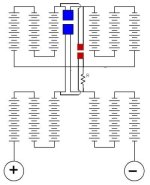Mr. Mik
1 kW
- Joined
- Sep 3, 2008
- Messages
- 390
This Inrush Current Limiter (ICL) is NOT the type which is used each time that you turn on your EV.
This ICL is to be used only after major repairs and service, before the battery is reconnected to the Motor Controller (MC). The MC is "constantly on", as long as it all works....
Here is a schematic of the battery without ICL:

The blue squares are the two parts of a 125A Andersons connector; it breaks the battery pack into three parts and makes it safe to disconnect the 125V pack from the MC.
The ICL needs to be connected BEFORE the parts of the blue Andersons connector are plugged together again (after a battery, MC or main fuse repair).
.
The next schematic shows the battery plus the ICL which I am prototyping at the moment:

These next picture show the half-finished prototype:


I hope this makes some sense so far...
.
Using this prototype ICL, the battery reconnection procedure would then be as follows:
Start by connecting the ICL (with the switches set as shown in the diagram and the pot turned to 5Ω).
Then connect the Ammeter to close the circuit, wait until the current has dropped and stabilized, then switch one switch at a time to reduce the resistance by a factor of about 10 each time, wait for the current to drop and stabilize each time, and last turn the potentiometer down to zero Ω.
Then the last switch could be flicked to allow higher current flow for testing etc without closing the main Andersons connector (but only if higher than 0.1A rated fuses were used).
Or (the more likely scenario), the Andersons connector can be closed with zero inrush current; after that, the ICL and ammeter get removed.
This ICL is to be used only after major repairs and service, before the battery is reconnected to the Motor Controller (MC). The MC is "constantly on", as long as it all works....
Here is a schematic of the battery without ICL:

The blue squares are the two parts of a 125A Andersons connector; it breaks the battery pack into three parts and makes it safe to disconnect the 125V pack from the MC.
The ICL needs to be connected BEFORE the parts of the blue Andersons connector are plugged together again (after a battery, MC or main fuse repair).
.
The next schematic shows the battery plus the ICL which I am prototyping at the moment:

These next picture show the half-finished prototype:


I hope this makes some sense so far...
.
Using this prototype ICL, the battery reconnection procedure would then be as follows:
Start by connecting the ICL (with the switches set as shown in the diagram and the pot turned to 5Ω).
Then connect the Ammeter to close the circuit, wait until the current has dropped and stabilized, then switch one switch at a time to reduce the resistance by a factor of about 10 each time, wait for the current to drop and stabilize each time, and last turn the potentiometer down to zero Ω.
Then the last switch could be flicked to allow higher current flow for testing etc without closing the main Andersons connector (but only if higher than 0.1A rated fuses were used).
Or (the more likely scenario), the Andersons connector can be closed with zero inrush current; after that, the ICL and ammeter get removed.






























